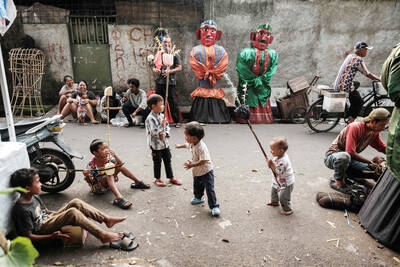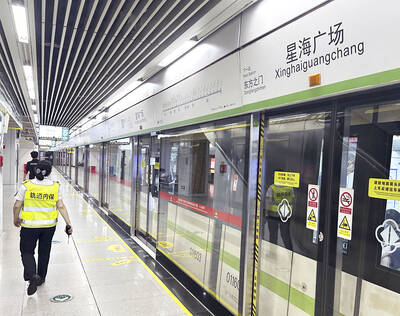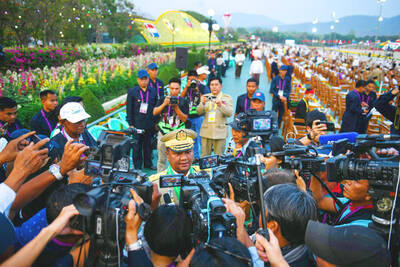If Colombia's leftist rebels safely deliver three hostages to Venezuelan President Hugo Chavez, it will likely increase pressure for government concessions to achieve what has so far proven impossible: the swap of 44 other high-profile captives for hundreds of rebels imprisoned in Colombia and the US.
As relatives and international observers gathered in Caracas on Thursday, Chavez was preparing to send Venezuelan helicopters into Colombia's lawless jungles yesterday in order to retrieve the initial three hostages from a rebel hideaway.
The liberation of former congresswoman Consuelo Gonzalez, Clara Rojas and her three-year old son Emmanuel -- a child allegedly fathered by a rebel captor -- is expected to take place in an unspecified Colombian location as early as Friday.
It's the latest move in a violent chess game between the rebels and Colombia's US-aligned government, which have been at war for five decades. A larger swap of hostages for rebel prisoners would be a much bigger move toward peace.
The Revolutionary Armed Forces of Colombia's (FARC) unilateral release of the first three hostages was announced as a goodwill gesture -- but it serves other purposes as well. Politically, the ploy has isolated the FARC's avowed enemy, Colombian President Alvaro Uribe.
Allowing the Venezuelans to cross battle lines and extract the hostages is risky for the rebels, since Colombia's military is sure to track the two Russian-made MI-17 helicopters authorized to enter its airspace. But the handover also tests the waters for more direct negotiations, which haven't happened since Uribe took office in 2002.
With tremendous mistrust on both sides, they haven't been able to come to terms on a temporary demilitarized zone where unarmed rebels and government representatives might come together with international observers to discuss a larger prisoner swap.
For Chavez, the rebels' hand-picked foil, it's an opportunity to revive a peacemaking role Uribe abruptly ended only weeks earlier after accusing the firebrand leftist of overstepping his mandate by contacting Colombia's army chief.
Chavez still hopes to mediate a broader swap of all the hostages for jailed rebels, one of his top ministers, diplomat Rodolfo Sanz, said on Thursday.
Chavez invited an international commission of observers from France, Argentina, Brazil as well as other Latin American countries to monitor the delicate operation. A planeload of international journalists will be following shortly behind to meet the hostages in Venezuela.
Uribe, vacationing at his ranch, has been all but sidelined from the humanitarian mission.
Publicly derided by Chavez as Washington's "lapdog," the leader now faces the greater insult of seeing Venezuelan military aircraft on Colombian soil.
Washington has been more amenable to Uribe's public threats to rescue the hostages militarily. But families of the hostages fear a bloodbath. Many past military encounters have ended with hostages being killed.

In the sweltering streets of Jakarta, buskers carry towering, hollow puppets and pass around a bucket for donations. Now, they fear becoming outlaws. City authorities said they would crack down on use of the sacred ondel-ondel puppets, which can stand as tall as a truck, and they are drafting legislation to remove what they view as a street nuisance. Performances featuring the puppets — originally used by Jakarta’s Betawi people to ward off evil spirits — would be allowed only at set events. The ban could leave many ondel-ondel buskers in Jakarta jobless. “I am confused and anxious. I fear getting raided or even

Eleven people, including a former minister, were arrested in Serbia on Friday over a train station disaster in which 16 people died. The concrete canopy of the newly renovated station in the northern city of Novi Sad collapsed on Nov. 1, 2024 in a disaster widely blamed on corruption and poor oversight. It sparked a wave of student-led protests and led to the resignation of then-Serbian prime minister Milos Vucevic and the fall of his government. The public prosecutor’s office in Novi Sad opened an investigation into the accident and deaths. In February, the public prosecutor’s office for organized crime opened another probe into

RISING RACISM: A Japanese group called on China to assure safety in the country, while the Chinese embassy in Tokyo urged action against a ‘surge in xenophobia’ A Japanese woman living in China was attacked and injured by a man in a subway station in Suzhou, China, Japanese media said, hours after two Chinese men were seriously injured in violence in Tokyo. The attacks on Thursday raised concern about xenophobic sentiment in China and Japan that have been blamed for assaults in both countries. It was the third attack involving Japanese living in China since last year. In the two previous cases in China, Chinese authorities have insisted they were isolated incidents. Japanese broadcaster NHK did not identify the woman injured in Suzhou by name, but, citing the Japanese

RESTRUCTURE: Myanmar’s military has ended emergency rule and announced plans for elections in December, but critics said the move aims to entrench junta control Myanmar’s military government announced on Thursday that it was ending the state of emergency declared after it seized power in 2021 and would restructure administrative bodies to prepare for the new election at the end of the year. However, the polls planned for an unspecified date in December face serious obstacles, including a civil war raging over most of the country and pledges by opponents of the military rule to derail the election because they believe it can be neither free nor fair. Under the restructuring, Myanmar’s junta chief Min Aung Hlaing is giving up two posts, but would stay at the